

Imagine walking into a store where everything is perfectly organized, products are easy to find, and helpful staff effortlessly guide you to what you need. Now, picture that same experience online—that's the power of well-structured SEO content for websites. In today’s digital bazaar, your website isn't just a virtual shop; it’s your round-the-clock salesperson working tirelessly to convert visitors into loyal customers.
Users take 2.6 seconds to focus on the most influential part of a webpage. Therefore, making the most important elements, like headlines or key visuals, stand out quickly to capture attention is critical. This helps create a strong first impression, essential for retaining users.
In this digital age, your website must be more than just a pretty face. It needs to be your hardest-working team member, optimized for every device (because let's face it, we’re all glued to our phones), with clear signposts (we call them CTAs in the digital world) guiding visitors towards that all-important 'Buy Now' button.
Ready to convert your website into a conversion powerhouse? Let's dive in and discover how to structure your content for maximum impact. Trust us, your future customers (and your bottom line) will thank you!
Before creating content, define your website's primary goal. Is it to market products, generate leads, or deliver information? For example, Flipkart primarily aims to sell products, while Practo focuses on connecting patients with doctors. Understanding your purpose guides your content strategy, ensuring every page contributes to your objectives.
Optimizing content for search engines is very vital for visibility. This is where SEO content for websites comes into play. If you're a clothing store in Delhi, use phrases like "trendy fashion in Delhi" or "affordable designer wear in NCR." Incorporate suitable keywords naturally throughout your content to allow search engines understand and rank your site.
Knowing your audience is crucial in creating engaging website content. Who are they? What do they want? Nykaa's website caters to beauty enthusiasts with detailed product information and makeup tutorials. Comprehending your target audience helps you create content that resonates with them and meets their needs.
Plan your website structure before writing. Decide on the main pages and their purposes. A restaurant website might have pages like 'Home,' 'Menu,' 'Reservations,' and 'About Us'. A clear outline ensures you cover all necessary information and helps organize your content effectively.
If your website includes a blog, brainstorm relevant issues that interest your audience. A yoga studio's blog might include topics like "5 Yoga Poses for Beginners" or "The Benefits of Meditation." Brainstorming helps you generate ideas and plan your content calendar.
A well-organized website makes things easy to find. Consider the user journey - how will visitors navigate from one page to another? Tata CLiQ's website offers clear categories and a simple yet comprehensive navigation menu. A good structure improves user experience and helps search engines understand your site better.
Ensure each page has a clear purpose. Your 'About Us' page should tell your brand story, and product pages should provide detailed information. MakeMyTrip's homepage immediately presents search options for flights, hotels, and holiday packages. Each section is clearly defined, with attractive visuals and concise, persuasive copy.
Stand out by creating content that reflects your brand voice and offers value. Paper Boat excels at this, using nostalgia-inducing narratives about traditional Indian drinks. Their 'Meethi Yaadein' section features childhood stories, creating an emotional connection with their audience. Think about what makes your brand unique.
Keep your language simple, clear, and aligned with your brand voice. Use short paragraphs, bullet points, and subheadings. BigBasket's product descriptions are concise yet informative, often bullet-pointed for easy reading. They use straightforward language to describe complex nutritional information. Focus on getting your ideas down in the first draft.
Effective copywriting can immensely impact your conversion rates. It's not just about describing your products or services; it's about compelling your audience to take action. Zomato's enticing food descriptions make readers crave the dishes. Good copywriting should highlight benefits, address pain points, and include clear calls to action.

While writing for your audience is crucial, don't forget about search engines. Use your target keywords seamlessly throughout your content. Include them in headings, meta descriptions, and image alt text. Healthkart, an online health store, effectively uses health-related keywords in its product descriptions and blog posts, improving its visibility in search results.
Visuals can make your content more interesting & easier to understand. On average, users spend just 5.59 seconds reading written content. Your website's text must be concise, ensuring visitors grasp critical information quickly. Include high-quality images, infographics, and videos where appropriate. Myntra's product pages feature multiple photos, size charts, and videos of models wearing the clothes. This helps clients make informed decisions & reduces return rates.
As mobile internet usage continues to rise in India, making your content easily readable on smaller screens is crucial. Utilize short paragraphs, ample white space, and a responsive design. Paytm’s mobile app and website provide a smooth, cross-device experience, allowing users to complete transactions effortlessly.
You should build customer trust with testimonials, reviews, and case studies. Flipkart prominently displays customer reviews on product pages. Urban Company (formerly UrbanClap) features success stories of service professionals on their website. This social proof can significantly influence purchasing decisions.
Maintain consistency across your website by creating a content style guide. This should include guidelines on tone of voice, formatting, and standard terms to use. HDFC Bank's website maintains a professional yet approachable tone across all pages, from product descriptions to their financial literacy blog.
Every page should have a clear purpose and guide users toward taking a specific action. Use compelling CTAs like "Shop Now," "Learn More," or "Get a Free Quote." MakeMyTrip uses bright, contrasting colors for their "Search" buttons, making them stand out and encouraging users to take the next step.
Slow-loading pages can drive visitors away. Optimize your images, minimize code, and use a content delivery network if necessary. Flipkart's website loads quickly, even with numerous images, ensuring a smooth shopping experience for users.

FAQ sections can address common customer queries and improve your SEO. Swiggy's FAQ page covers various topics, from the ordering process to delivery partner queries. This reduces customer service inquiries and provides valuable information to potential customers.
If you're targeting different regions in India, consider creating localized content. Amazon India offers content in multiple languages and showcases region-specific deals and products. This approach can help you connect with local audiences and improve your search rankings for location-specific queries.
Read: How LexiConn Helped Amazon Increase Web Traffic with SEO Blogs
Update your content regularly to keep it fresh and relevant. This is particularly important for time-sensitive information like prices, product availability, or current events. NDTV's website constantly updates its content, ensuring visitors always have access to the latest news and information.
Leverage the power of internal links, as they are helpful for navigation and help search engines understand your site structure. Naukri.com effectively uses internal linking to guide job seekers to relevant job listings, career advice articles, and resume services. The result? Engaged users who wish to explore more services.
Schema markup is an excellent way to help search engines understand your site and improve the appearance of your search results. Bookmyshow uses schema markup for movie showtimes, ratings, and reviews, which can appear directly in search results, attracting more clicks.
While timely content is essential, also focus on building evergreen content that remains relevant over time. ICICI Bank's financial education blog features timeless articles on budgeting and investment basics, providing long-term value to readers and consistent traffic to their website.
Voice assistants are becoming popular, so your website should be voice-optimized. This often means using more conversational language and focusing on question-based queries. Practo's symptom checker is an excellent example of using natural language to help users identify potential health issues.
Incorporate powerful words that evoke emotion or urgency to make your copy more compelling. Words like "exclusive," "limited time," or "guaranteed" can drive action. Myntra effectively uses powerful words in its sale announcements to create excitement and encourage immediate purchases.
As apremier content marketing agency in Mumbai and a content writing agency in India, LexiConn is uniquely positioned to help businesses maximize their online presence. We understand the intricacies of creating SEO content for websites that rank well and engage and convert visitors.
Our expert writers specialize in crafting optimized website content that resonates with your target audience. We dive deep into your business, understanding your goals and audience, to create business-driven content writing that aligns perfectly with your brand voice and objectives.
At LexiConn, we don't just write; we strategize. Our comprehensive approach includes keyword research, content planning, and implementation of best practices for website structure and SEO. We create engaging website content that tells your brand story, highlights your unique selling points, and guides visitors toward desired actions.
Whether you need a complete website content overhaul or regular blog posts, our content writing agency in Mumbai can deliver. We offer tailored solutions to businesses across India.
Structuring your website content for maximum impact involves a combination of SEO best practices, user-friendly design, and compelling content creation. By following these guidelines and learning from successful Indian examples, you can create a website that ranks well in search engines, provides value to your visitors, and drives your business goals.
To stay ahead, you need to adapt and innovate continually. For more writing and formatting case studies resources, get a 30-minute free consultation with LexiConn. Our expert team is ready to help you transform your website content into a powerful conversion tool. Contact us today at [email protected] or visitwww.lexiconn.in to learn more about our services.
Structuring your website content for maximum impact involves a combination of SEO best practices, user-friendly design, and compelling content creation. By following these guidelines and learning from successful Indian examples, you can create a website that ranks well in search engines, provides value to your visitors, and drives your business goals.



I have read and accept the Privacy Policy
Read More